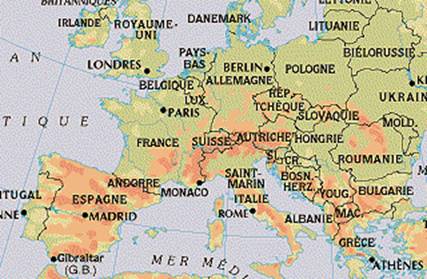
* The French territory can be described as follows :
France has a key position in Western Europe. Situated between Spain, Italy , the UK Belgium and Luxemburg and Germany, it is a gateway to all these countries .
Situation map / www.image s.goggle.fr
The French territory was built by the French kings who have been ruling the country since the medieval periods until its final limits in 1860. French people speak the same language, and have a common history.
However, some people in France are attached to local customs and speak regional languages .
France has two maritime borders, the Mediterranean Sea and the Atlantic Ocean
Besides, the high mountains in the Eastern contrast with the plains and plateaux in the Western areas.
There is a wide variety in climate temperatures, hence a wide range of landscapes.
* Relief :
It reflects the different natural environments to be found in Europe. The hexagonal territory articulates onto 2 complexes relief, arranged on both side a Southwest diagonal / Northeast diagonal.
A large amphitheatre, consisting of plains, wide river valleys and continental shelves, opens onto the Atlantic Ocean and the North Sea. The South and the East of the country present more contrasted reliefs. The heart of the Alpine and Pyrenean massifs are decorated with sharp and little hospitable tops. All arround them , the PreAlps, the Jura, the oriental border of the Central Massif and the Vosges expose heavy forms. The very diverse French coasts vary from swamps, to cliffs, lagoons and rocky coasts.
relief / www.images.goggle.fr
* Countryside regions:
Many imbalances in the occupation of the territory have always existed, with Paris on the one hand, and the industrial Eastern regions and Western farm areas on the other hand..
Yet, owing to new policies concerning the development of the territory, these differences are decreasing.
Yet no balance between big cities that attract an increasing number of people, and some rural areas that are becoming quite deserted regions, especially near mountainous places such as Corsica and Le Massif Central..
Paris is the historical heart of the conglomeration, with an environment often previous to the 20th Century. The suburb consists in the small crown with a very dense environment and the distant suburb, the big crown is formed by detached houses, small buildings and great complexes.
The commutings between the suburb and Paris are very important either by car or by train. In the morning vast traffic jams surround the accesses to the capital city.
Paris possesses numerous offices and welcomes numerous specific services. The suburb possesses equipments requiring more space : warehouses, market of Rungis, big shopping centers and airports. The industry is especially concentrated in the North, while the Southwest gathers the activities of research and high technology, and the East, the activities are connected to the transport means. In the surroundings of Paris remain forests areas which have become zones of leisure activities and farmlands.
Paris Basin , thanks to rich grounds, is devoted to farming, produces cereals, associated to oleaginous plants. The farmers cultivate very big exploitations (superior to 100 hectares) .At the periphery, there are other big productions: breeding in Normandy, wines and fruit in the Val de Loire and famousVineyards in Champagne.
From the North to Alsace, industrial activities had always been present owing to a large reservoir of labour force. Today, except for Alsace, all these areas are undergoing a process of economic reconversion. Foreign and French car makers have settled there, due to the financial help from the State they could be entitled to, and also owing to the manpower to be found there, as well as the proximity of other European countries.
Services are developing quite fast together with trade activities, transport facilities, and leisure centers. Large cities have developed “technopoles”.
However, the rate of unemployment is still high and young people are leaving these regions to go and work elsewhere.
It represents a major area linked to the busy areas of the country center ( the Rhine region, Paris and North Italy) and the Mediterranean zone.
The South-East is the main magnet for the moment attracting industries and people, and developing many “ eurotechnopoles”:
Crossroads of new technologies, such as for instance, the innovative and scientific zone of Grenoble, the activity complex of Sophia Antipolis near Nice, “ la Part-Dieu ” and the Gerland suburbs in Lyon, second biggest city in France. The Rhône valley in the South of Lyon, where stand the famous Feyzin oil refinery and many other industrial complexes and research centers. As a result , this part of the country has been named “ the hallway to chemistry”.
This is a privileged area for leisure: there is a wide choice of touristic attractions , from skiing and summer resorts to art towns, music festivals, spas and so on.
The “Paca” area
It corresponds to “ la Provence-Alpes-Côte d’Azur”, with the South Alps area, rather deserted and the densely populated sea coast from Menton to Marseille and the lower part of the Rhône.
Marseille is a huge sea-port and a famous Southern city
The “ Languedoc-Roussillon”
This plain abounds in vineyards and is a wine-producing area. Since 1963, the State has re-organised the sea coastal area and modern summer resorts have been built to make the place more attractive.
Montpellier is benefiting a lot from high- tech activities.
The “ Midi-Pyrénées” area
This is a plain bordered by le Massif Central in the North and les Pyrénées in the South. A quarter of the whole population is concentrated in Toulouse, owing to its dynamism coming from the aero-space and high-tech industries that are settled there.
These areas are rural ones. Farming activities are much developed. From “ la Bretagne” to “Poitou-Charentes , dairy products are grown. Together with cereal-growing. Tourism is also important thanks to traditional local “ savoir-faire” . New road links have been built leading to Europe and to dynamic regional capital city such as Bordeaux, Nantes and Saint Nazaire.
The West has a long sea coast of about 1700 kms fronting the Atlantic ocean and the Channel. Coastal areas are varied: some are sandy and flat like “ les landes”, some are rocky and jagged like in “ la Bretagne” , cliffs in “ Basse- Normandie” and two estuaries running deep into the mainland, “ la Loire “ and “ la Gironde”.
The influence of the sea on the climate is very high. It is a damp zone owing to the ocean winds.
Fishing activities are developing along the coast as well as oyster-farming.
The beaches are now much visited by tourists, and there is a recent developping of cruising and sea therapy.
These territories are part of the French territory, enriching it with many different environmental varieties and people of various origins.
They are from African , Indian and European origins, and there is a lot of interbreeding .
Agriculture keeps a lot of the working population busy but most employments are to be found in public services like schools, hospitals, police. Tourism is to be sure highly flourishing.
However, unemployment is still running very high, higher than in the home country.
Overseas territories of Francewww.images.goggle.fr
* The flag : National symbol of the 5 th Republic, the three-coloured flag was born during the French Revolution of 1789, mixing the King’s colour (white) and the colours of the city of Paris (blue and red). Nowadays, the three-coloured flag wave at the top of all the public buildings, and is displayed in most official civil, military ceremonies either.
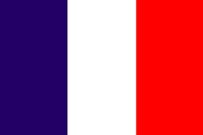
French flag www.images.goggle.fr
* The Gallic cock : The cock has appeared since the Antiquity, and was minted on Gallic coins.It has become the symbol of Gaule and of the Gauls ; After a play on words : the Latin word “Gallus” meaning either cock or Gaul. Today, if the French Republic prefers the symbol of the Marianne, the cock still figures on the State seal : the liberty sat holding a wheel on which the cock is represented.It is mostly used abroad, to represent France, especially as the French Sport emblem.
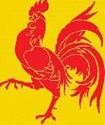
The Gallic Cock www.images.goggle.fr
* The Marianne : She is the emblem of the French Republic and a symbol of liberty. She appeared during the French Revolution. Nowadays, Marianne has been represented throughout different French actresses. You can also find her on several different items as stamps for example.

The Marianne www.images.goggle.fr
* The “Phrygien” Bonnet : Symbol of freedom, it was worn by the freed slaves during the Antique Greece. It was then used by seamen and galley-slaves in the Mediterranean sea. During the French Revolution, it was used by the revolutionaries.
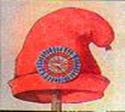
* The 14 th of July : Parisian Revolutionary day, which became National Day on the 14 th of July is now associated to the solemnity of the military parades and to the conviviality of balls and fireworks. The fall of the Bastille, on the 14 th of July 1789, has been celebrated in France for more than a century, and is really popular.In Paris, the traditionnal military parade on the Champs-Elysées is prepared with great care. On this day, everywhere in France there are somme balls, illuminations and fireworks.
The takeover of the Bastille www.images.goggle.fr
* The Marseillaise : Originally it was a revolutionary war song and the liberty hymn, then the Marseillaise gradually became the national anthem. Nowadays, you can hear it in most official events.
The author, from whose ashes were laid at the Invalides in 1915, was Claude Joseph Rouget de Lisle, captain in engineering, a moderate revolutionary man, saved from the “Terror” thanks to his song.
France is divided into :
Regions : 22 regions gathering 2 to 8 counties. These regions are highly diversified. Their Heads are elected too, through the universal suffrage.
Counties : there are 96 in the home country and 4 overseas. Each county is identified by a name, for example : La Côte d’Or and a code number which can be seen on car registration plates and postal code (21 for La Côte d’Or). Counties are run by a General Council, elected by the people through the universal suffrage.
Communes : 36000 “communes”, 183 of them overseas. The “commune” is the smallest unit of the territory. According to its population, it is called “a commune”, a “village” or a “town”.
Towns over 100 000 inhabitants
|
36 |
Towns from 30 000 to 100 000 inhabitants
|
190 |
Towns from 10 000 to 30 000 inhabitants
|
574 |
Towns from 2000 to 10 000 inhabitants
|
3219 |
“Communes” under 2000 inhabitants
|
32546 |
The French are deeply attached to their “communes”,there are run by a mayor and a city council are elected by the people through the universal suffrage.
Regions and counties
France of the distance : The French possessions overseas include approximately 2.3 million inhabitants. They were former colonial lands remote from the Metropolis. Some became Departments of Overseas (DOM) and the other Territories Overseas (TOM), which guarantees them a larger autonomy.
A varied range of climates: except for the rigorous mountain climate, the country presents in a double climatic characteristic. The oceanic climate offers the advantages of a relative winter. The mediterranean climate offers pleasant winters, and generous sunshine period but aridity combined with scorching heat summers sometimes constitutes a handicap. The continental climate : the winters are characterized by periods of rather pronounced frost and rather durable snow coverage. The summer season knows heavy and stormy hot times. The annual pluviometry is rather reduced enough.
There are over 60 million inhabitants, with approximately 107 inhabitants per square Kms. As to the population growth, we can notice :
- A low birthrate and a decrease in immigration
- An aging population, in the short term, this is going to raise a key problem about how to finance retirement schemes, or how to operate the replacement of the working population in different fields professional.
75 % of French are living in towns, the urban growth had been fast from 1945 till 1970, because of an important drift land. Half of the city-dwellers have left to settle down in the countryside close to the cities, while work into towns. It pulls the periurbanisation today. Many young people leave the old industrial areas of the North and the Northeast because of lack of work.
The Paris region attracts the young assets. The Western an Southern regions attract the immigrants because of its pleasant environment (sea, sun, nature) and because of new jobs such as: services, or high technology.

Evolution of births www.images.goggle.fr
Evolution of french population (2001)
During the “ Trente Glorieuses”, a historical period from 1945 to 1975, many foreign people,mostly from “ le Maghreb” and Africa , came to France hoping to find a job. However, since 1974, owing to the rise of unemployment, the State has decided to limit the rate of immigration.
In 2000, France had 3.3 million legal immigrants, which accounted for 5.6% of the whole population. They have settled mostly in large cities such as Paris, Lyon, Marseille.
Part of immigrants in France in 2001
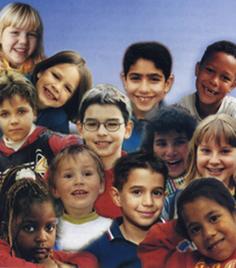
Diversity into schools
* PARIS : the capital of the country, has grown into a huge city with 10 million inhabitants, 2.2 millions of them living right in the heart of Paris. It is the home of the President , of the Parliament and of the Prime Minister.
With the exception of steel industries, all industries can be found in and around Paris as well as all types of services ranging from the most basic services to high-tech ones. There are world-famous libraries, 13 universities and many top-level school institutes. More than a quarter of the country’s students are studying there.
Its patrimony, in terms of architecture is an exceptional one. Besides, the city enjoys a reputation for being a luxury place with a “ special art de vivre”. Paris is a leading touristic City and a famous center where world congresses and fairs are held.
Getting to Paris from anywhere in the world is no problem at all thanks to a well-developed network of transport, either by air ( international airports at Roissy and Charles de Gaulle ) or by land ( highways and TGVs).
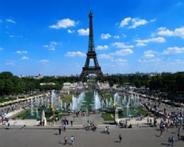
Paris www.images.goggle.fr
* LYON : With more than 1.3 million inhabitants, Lyon is the second French town. It attracts young qualified assets thanks to its economic dynamism and to its environment. The region of Lyons possesses important chemical and metallurgical industry. It is the second town for the services with banks and research centers. New districts underline the dynamism of the city: the “Part- Dieu” became the big business center and the Gerland district concentrates research activities linked to health. International bodies have settled down there: such as Interpol, OMS.
Lyon www.images.goggle.fr
* MARSEILLE : A Very large port of the Mediterannean Basin, Marseille has extended in the years 1970 with installation of the zone of « Fos sur Mer » welcoming raw materials
( Coal, iron, oil, petroleum) as well as the industries to transform them. Today the rehabilitation of the old center, the construction of thousand offices, the development of the cruises, the arrival of the high-speed train (TGV) has given a second breath to the city.
* LILLE : The town of Lille, the only big French conurbation with the former pits of Lille, Roubaix, Tourcoing and recently Villeneuve d’Ascq, represents the 3rd national urban pole (1.6 million of inhabitants) and it’s the nearest one to the French border. Lille has known an important growth of the services. The TGV and the construction of a big business centre (Euralille) has strengthened the dynamism of the city.
* NICE: The main city of this “ Côte d'Azur” region attracts many tourists from Northern Europe and overseas France, they are seduced by sea, sun and the beauty of the landscapes.
* METZ AND NANCY : ( Lorraine) had been equipped with technopôles to attract high technology companies.
* STRASBOURG : ( Alsace) has welcomed the European parliament.
* MONTPELLIER : (Langedoc Roussillon) benefited from the development of the high technologies activities.
* TOULOUSE : (Midi-Pyrénées) had owed its dynamism to the aircraft (Airbus), aerospace and high technology industries.
* NANTES AND BORDEAUX : Atlantic ports.
France is a tourist country because of its exceptional tourist capital : natural sites, particularly sunny coasts and snowy mountains, are places of holiday resort, with many sports activities. The internal regions of low mountains or the fresh valleys welcome adepts of a green tourism.
This country has a very rich historic and cultural patrimony: prehistoric caves, castles, urban architecture, museums. The French culture also attracts numerous festivals, exhibitions and pilgrimages. Finally, the gastronomy is enriched with a very big regional varieties. Parks of attraction, settled in France, such as Disneyland Paris in Marne la Vallée attract many international customers.
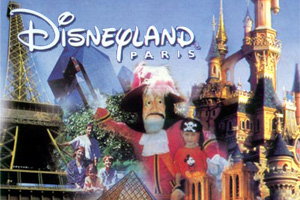
Disneyland Paris www.images.goggle.fr
Paris remains the most frequented foreigner tourist pole. Coasts, especially mediterranean ones are full of tourists. Winter sports resorts concentrate the maximum of their activities during school vacations.
The French tourist potential, France privileged position profit from a great economic activity thanks to adapted equipments.